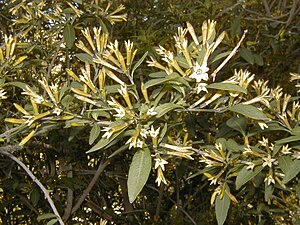Chilean hammer bush
| Chilean hammer bush | ||||||||||||
|---|---|---|---|---|---|---|---|---|---|---|---|---|

Chilean hammer bush ( Cestrum parqui ) |
||||||||||||
| Systematics | ||||||||||||
|
||||||||||||
| Scientific name | ||||||||||||
| Cestrum parqui | ||||||||||||
| L'Hér. |
The Chilean hammer bush ( Cestrum parqui ) is a type of plant from the genus of hammer bushes that occurs in tropical America.
features
The Chilean hammer bush forms trees or shrubs up to 2 m high. The narrow leaves smell unpleasant, the yellow tubular flowers are in axillary clusters. The initial green berries are black when ripe.
The number of chromosomes is 2n = 16.
Occurrence
The Chilean hammer bush is native to Bolivia, Brazil, Paraguay, Uruguay, Argentina and Chile. The plants, which originally came from the tropical parts of America, were exported worldwide as ornamental plants. They have become a stubborn weed in many areas.
use
Active ingredients
Cestrum species, including the Chilean hammer bush, contain carboxyparquine , a terpene, as a poison. The substance is the significantly more poisonous of the two kaur glycosides and can be isolated from the dried leaves of the plant. Structurally it is closely related to the atractyloside . In addition to the two parquins, it also contains saponins .
use
The plant was smoked as an intoxicating and stimulating agent as early as the 16th century. The plant was sometimes used in traditional medicine.
Symptoms
Cattle have increased salivation, watery eyes and colic , a hunched back, general weakness, unsteady gait and abdominal pain. Furthermore, liver lesions occur. In humans, poisoning leads to violent vomiting, abdominal pain, headache, cramps. After a rapid deterioration in health, death occurs after the coma .
pharmacology
The active ingredients of the Chilean hammer bush are cell toxins and classified as psychoactive with a toxicity of Ib-II. The substances atracyloside and carboxyparquine, which are toxic to mammals, lead to symptoms similar to those of poisoning with strychnine . Allegedly, the Chilean hammer bush has already caused deaths in livestock. The toxins are not broken down in dried plant material. If cut material, for example from hedges, is used to feed animals, poisoning can occur. The fruits of the plant are ten times more poisonous than other above-ground parts of the plant. Death usually occurs within a few hours. 200 g of dried leaves are fatal for cattle, 15 g for goats. The LD 50 for mice is 4.3 mg / kg carboxyparquine.
First aid and clinical therapy
As an immediate measure, activated charcoal and sodium sulfate are administered . In the clinic, gastric lavage as well as the application of activated charcoal and sodium sulphate and acidosis therapy with sodium carbonate , possibly also intubation and oxygen treatment, are carried out in the clinic .
literature
- Michael Wink, Ben-Erik van Wyk, Coralie Wink: Handbook of poisonous and psychoactive plants. Scientific publishing company, Stuttgart 2008, ISBN 3804724256 .
Individual evidence
- ↑ Cestrum parqui at Tropicos.org. In: IPCN Chromosome Reports . Missouri Botanical Garden, St. Louis
- ^ Cestrum in the Germplasm Resources Information Network (GRIN), USDA , ARS , National Genetic Resources Program. National Germplasm Resources Laboratory, Beltsville, Maryland. Retrieved November 28, 2017.
